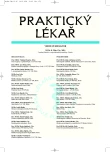-
Medical journals
- Career
Prevalence and longitudinal trends in prescription of potentially inappropriate medications for the elderly in the Czech Republic
Authors: J. Vinšová 1; D. Fialová 1,2; E. Topinková 2; J. Vlček 1; M. Wawruch 3; Z. Vitásek 4
Authors‘ workplace: Katedra sociální a klinické farmacie, Farmaceutická fakulta UK v Hradci Králové, Vedoucí: Doc. RNDr. Jiří Vlček, CSc. 1; Geriatrická klinika, 1. Lékařská fakulta UK v Praze, Přednostka: Prof. MUDr. Eva Topinková, CSc. 2; Farmakologický ústav Lékařská fakulta Univerzity Komenského v Bratislavě, Slovenská republika, Přednostka: Doc. MUDr. Viera Kristová, CSc. 3; Zaměstnanecká pojišťovna Škoda, Mladá Boleslav, Ředitelka: Ing. Darina Ulmanová 4
Published in: Prakt. Lék. 2006; 86(12): 722-728
Category: Therapy
Overview
The article deals with an evaluation of the prevalence and trends in prescribing potentially inappropriate medications for Czech senior citizens in out-patient care. It uses the newly revised and, in the Czech Republic, to date less known Beers’s criteria 2003 (10), listing medications potentially inappropriate for the elderly based on pharmacological and pharmacoepidemiological studies. Prescription of these medications in the elderly should be low, but previous studies have documented their frequent use in several European countries, including the Czech Republic (7). The most extensive sample has ever been analyzed in the Czech conditions - the dataset of 1 776 119 drugs dispensed on medical prescription to the over 65s insured through the ·koda Employee Insurance Company, Mladá Boleslav, Czech Republic, during the period January 1997 – December 2001.
The analysis documented frequent use of potentially inappropriate medications, in 40 % of out-patient seniors in 1997 and in 30 % in 2001. When only “highly risky” medications were considered, the prevalence reached was also high – 34 % in 1997, with only mild longitudinal decline over time – 26% in 2001. Among inappropriate medication users, females and “older” seniors (75 – 84 years old) were particularly identified. In the period studied, long-acting benzodiazepines and nitrofurantoin (11 % and 6 % in 1997, respectively) were the most frequently dispensed medications, with a nearly unchanged prevalence over time. The use of ergot mesyloid, indomethacin and short-acting nifedipin decreased; use of doxazosin, ticlopidin, and short-acting oxybutinin increased.Key words:
geriatrics, potentially inappropriate medications in the aged, prevalence and trends, Beers´s criteria
Labels
General practitioner for children and adolescents General practitioner for adults
Article was published inGeneral Practitioner

2006 Issue 12-
All articles in this issue
- Role of coronary calcium scoring in a spectrum of examination procedures
- Restoration of hand movement following irreparable radial nerve palsy
- Prevalence and longitudinal trends in prescription of potentially inappropriate medications for the elderly in the Czech Republic
- Family structure and life style of Czech children
- Reasons for admission into old people’s homes.
- Hyperhomocysteinemia and ischemic stroke
- Stem cells in patients with heart failure following myocardial infarction
- Occupational viral hepatitis in southern Moravia from 1988 to 2004
- Comments from healthy people that may stress patients
- Neurosyphilis
- Choroidal detachment as a first sign of a haematological malignancy
- Benign paroxysmal positioning vertigo - a diagnostic problem?
- Severe lactic acidosis associated with acute renal failure in a diabetic patient treated with metformin – A case study.
- Is diagnosis of lyme borreliosis still difficult?
- General Practitioner
- Journal archive
- Current issue
- Online only
- About the journal
Most read in this issue- Severe lactic acidosis associated with acute renal failure in a diabetic patient treated with metformin – A case study.
- Role of coronary calcium scoring in a spectrum of examination procedures
- Restoration of hand movement following irreparable radial nerve palsy
- Neurosyphilis
Login#ADS_BOTTOM_SCRIPTS#Forgotten passwordEnter the email address that you registered with. We will send you instructions on how to set a new password.
- Career

